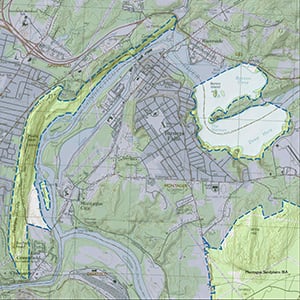Important Bird Area Sites in Massachusetts
Important Bird Area: Barton's Cove Poets Seat
Site Summary
Nominated By
Diane Potter, Mark Taylor
Size
300+ acres
Towns and Counties
Gill, Greenfield, Turners Falls; Franklin County
Ownership
US Fish and Wildlife Service, municipal, private
Major Habitats
Barton's Cove: 98% river/stream Rocky Mountain Ridge: 30% northern hardwood forest, 70% oak-conifer transitional forest
Land Use
hunting & fishing, suburban/ residential, wildlife conservation, recreation, fisheries, water supply, utilities, research, and undeveloped areas
Serious Threats
invasive species, cowbirds, succession, deforestation, overfishing, predation, pesticides, water pollution, soil erosion, habitat conversion, disturbance, some illegal dumping
IBA Criteria
- Category 1: Sites important for long-term research and/or monitoring projects that contribute substantially to ornithology, bird conservation, and/or education.
- Category 5: Sites regularly holding significant numbers of an endangered, threatened, vulnerable, or declining species.
Site Description
Barton Island has been a Bald Eagle nest site since 1989, and surrounding waters adjacent to the nest are off-limits to the public. The Barton's Cove Bald Eagle "nest program" is managed by MassWildlife. Barton's Cove is also a recreational area with boat launching, sightseeing tours, kayaking, duck hunting, and ice fishing. Barton's Cove is a large outflow of the Connecticut River, in Gill, just above the Turners Falls dam. A short distance upriver is another similar cove/outflow that can be accessed from the Turners Falls side (Turners Falls Rod & Gun Club). A deeper main channel feeds the relatively shallow waters. It is in this area that migratory waterfowl stop over or stage. At the southwestern edge of Barton's Cove is Barton Island, where Bald Eagles have nested since 1990t. Similar shallow water and grassy island habitat is situated in the area of the Turners Falls Rod & Gun Club. These small patches are periodically flooded due to water level fluctuations. Deciduous woodlands of varying age rise along the riverbanks.
Rocky Mountain Ridge is bordered by the Connecticut River to the east and extends from the ridge above Abercrombie Field at the south end, north to the bend in the river near the Turners Falls Dam, and includes the Silvio O. Conte National Fish and Wildlife Refuge's recent Wissatinnewag purchase. The ridge is a largely town owned, forested tract, and is crossed by many hiking trails. The Highland Park section contains several small wooded swamps and a small pond contiguous to the nominated area. Staff at the Silvio O. Conte National Fish & Wildlife Refuge describe Rocky Mountain ridge as essentially the same in terms of ecological importance as the refuge's Wissattinewag parcel. Rocky Mountain stands as an individual segment of traprock ridge extending from Saybrook, Connecticut, to Northfield, Massachusetts. The more gentle eastern side, sloping to the Connecticut River, catches the morning sun, creates a shelter from north-northwest winds, and acts as a funneling flyway during inclement weather. The ridge also hosts excellent numbers of early arrivals.
Current Conservation Status
The majority of Rocky Mountain Ridge is owned by the town of Greenfield, and as such is viewed as a recreation, not conservation, area. A portion has been proposed as a campsite. The sensitive vegetation around Highland Pond has been subject to uprooting rare plants, and cutting of vegetation during the breeding season. Illegal dumping is a problem along the paved road to the tower. All-terrain vehicles are used in the Highland Park section and are an increasing problem within the area. Some areas around Highland Park are still subject to development, and Franklin Land Trust has considered some wetland areas for protection.
Ornithological Significance
Data kept by Brad Blodget, state ornithologist for MassWildlife from 1989 to 2001, has shown Barton's Cove to have at least a "housekeeping" pair of Bald Eagles on territory each year. USFWS in conjunction with Northeast Utilities has created local and regional interest through a media/monitoring program. A video camera is set up above the nest, and progress of nest activities is broadcast over local television. The Bald Eagle pair successfully hatched, raised, and fledged two chicks in 2002. Records since 1993 have shown that water birds have been present in variable numbers at Barton's Cove and/or Turners Falls Rod & Gun Club during migration (i.e., 55 Common Loons in 2000 on the cove, 200+ Ring-necked Ducks 200+ in 2000, and numerous Horned and Red-necked grebes.
Rocky Mountain Ridge is exceptionally rich in its diversity of species, especially during migration, but is also an important area for breeding birds, and wintering individuals (Criteria 3g, Single-Species Concentrations). It should also be mentioned that both "Brewster's" and "Lawrence's" warblers have been sighted here, attesting to the possibility of Golden-winged Warblers breeding at this site, or on the contiguous Kell's Farm property at the southern base of Poet's Seat.
Other Flora or Fauna of Significance
Extensive vegetation list provided by Natural Heritage and Endangered Species Program and biodiversity days surveys.
Data Sources
D. Potter, personal records (1990-2002), Silvio O. Conte National Fish & Wildlife Refuge Migratory Bird Stopover Habitat Survey (transect A3) data, A Bird Finding Guide to Western Massachusetts, and Bird News of Western Massachusetts.




